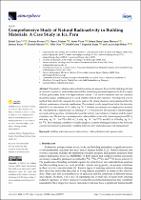Comprehensive Study of Natural Radioactivity in Building Materials: A Case Study in Ica, Peru

View/
Author(s)
Liz, Rafael
Pereyra, Patrizia
Muñoz, Daniel
Viera, Victor
López Herrera, Maria Elena
Rojas, Jhonny
Palacios, Daniel
Díaz, Félix
Cerna, Nhell
Rojas, Segundo
Sajo-Bohus, Laszlo
Date
2023Metadata
Show full item recordPublisher
MDPI
Journal
Atmosphere
Abstract
This study evaluates radon exhalation rates and assesses the potential radiological risks of external exposure to primordial radionuclides in building materials employed in the Ica region of Peru, particularly those with high uranium content. The radon exhalation rates are currently measured using a combination of a closed chamber and an active monitor. We proposed a novel method that effectively ensured a hermetic seal for the closed chamber and guaranteed that the efficient maintenance of secular equilibrium. The obtained results ranged from below the detection limit (BDL) to a maximum of 52.3 mBq · kg−1h−1. Gamma spectrometry was employed to measure the concentrations of radionuclides by utilizing a 3′ × 3′ NaI detector. The analysis of cement samples revealed a strong positive correlation between the activity concentration of radium and the radon exhalation rate. The activity concentrations for radionuclides varied, with values ranging from BDL to 60.6 mBq · kg−1h−1 for 226Ra, BDL to 22.3 mBq · kg−1h−1 for 232Th, and BDL to 1074 mBq · kg−1h−1 for 40K. These findings contribute valuable insight to decision-making processes in the Peruvian construction industry, particularly regarding material safety and radiological risk management.
Type
info:eu-repo/semantics/article
Rights
info:eu-repo/semantics/openAccess
Language
eng
Collections
- Ingeniería Civil [8]

